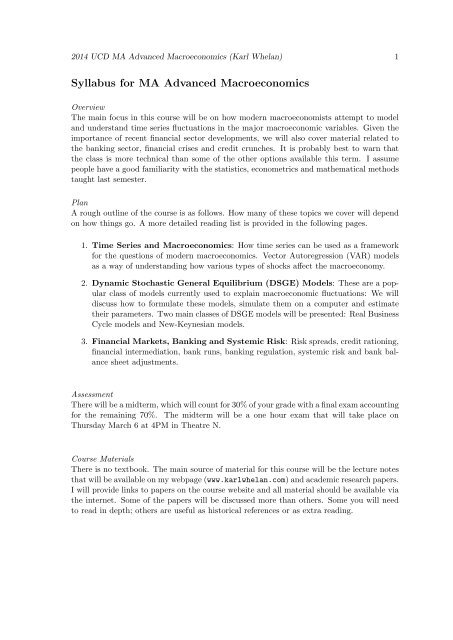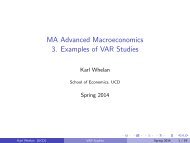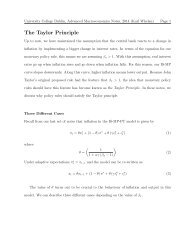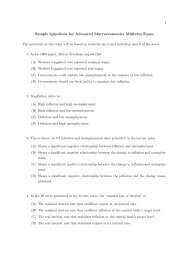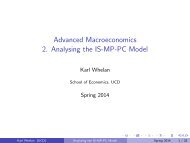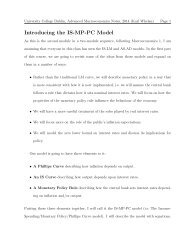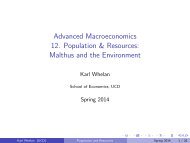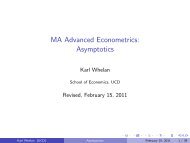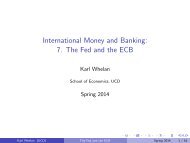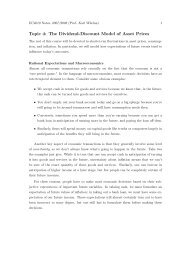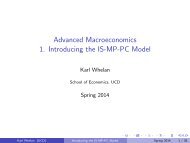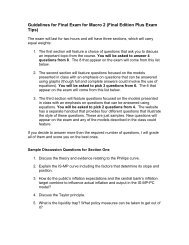Here - Karl Whelan
Here - Karl Whelan
Here - Karl Whelan
Create successful ePaper yourself
Turn your PDF publications into a flip-book with our unique Google optimized e-Paper software.
2014 UCD MA Advanced Macroeconomics (<strong>Karl</strong> <strong>Whelan</strong>) 1<br />
Syllabus for MA Advanced Macroeconomics<br />
Overview<br />
The main focus in this course will be on how modern macroeconomists attempt to model<br />
and understand time series fluctuations in the major macroeconomic variables. Given the<br />
importance of recent financial sector developments, we will also cover material related to<br />
the banking sector, financial crises and credit crunches. It is probably best to warn that<br />
the class is more technical than some of the other options available this term. I assume<br />
people have a good familiarity with the statistics, econometrics and mathematical methods<br />
taught last semester.<br />
Plan<br />
A rough outline of the course is as follows. How many of these topics we cover will depend<br />
on how things go. A more detailed reading list is provided in the following pages.<br />
1. Time Series and Macroeconomics: How time series can be used as a framework<br />
for the questions of modern macroeconomics. Vector Autoregression (VAR) models<br />
as a way of understanding how various types of shocks affect the macroeconomy.<br />
2. Dynamic Stochastic General Equilibrium (DSGE) Models: These are a popular<br />
class of models currently used to explain macroeconomic fluctuations: We will<br />
discuss how to formulate these models, simulate them on a computer and estimate<br />
their parameters. Two main classes of DSGE models will be presented: Real Business<br />
Cycle models and New-Keynesian models.<br />
3. Financial Markets, Banking and Systemic Risk: Risk spreads, credit rationing,<br />
financial intermediation, bank runs, banking regulation, systemic risk and bank balance<br />
sheet adjustments.<br />
Assessment<br />
There will be a midterm, which will count for 30% of your grade with a final exam accounting<br />
for the remaining 70%. The midterm will be a one hour exam that will take place on<br />
Thursday March 6 at 4PM in Theatre N.<br />
Course Materials<br />
There is no textbook. The main source of material for this course will be the lecture notes<br />
that will be available on my webpage (www.karlwhelan.com) and academic research papers.<br />
I will provide links to papers on the course website and all material should be available via<br />
the internet. Some of the papers will be discussed more than others. Some you will need<br />
to read in depth; others are useful as historical references or as extra reading.
2014 UCD MA Advanced Macroeconomics (<strong>Karl</strong> <strong>Whelan</strong>) 2<br />
Contacting Me<br />
My office is D216 in the Newman Building. Email (karl.whelan@ucd.ie) is the best way<br />
to contact me to ask questions or to arrange a meeting. I am generally good at replying<br />
quickly but send me a reminder if I haven’t gotten back to you in 24 hours.<br />
Part 1: Time Series and Empirical Macro<br />
• Time series modelling as a framework for understanding macro.<br />
• Introducing VARs.<br />
• Reduced form versus structural VARs.<br />
• Recursive VARs. Cholesky decomposition.<br />
• Estimating VARs.<br />
• Identifying the effects of oil shocks, monetary policy shocks, fiscal policy shocks.<br />
• VARs with long-run restrictions and identifying the effects of technology shocks.<br />
Readings:<br />
• John Cochrane (2005). Time Series for Macroeconomics and Finance (Chapters 2, 3,<br />
5 and 7). Lecture notes, available at<br />
faculty.chicagobooth.edu/john.cochrane/research/papers/time_series_book.pdf<br />
• Christopher Sims (1980). “Macroeconomics and Reality,” Econometrica, Vol. 48,<br />
pages 1-48.<br />
• Marta Banbura, Domenico Giannone, and Lucrezia Reichlin (2008). Large Bayesian<br />
VARs. ECB Working Paper 966. Available at<br />
http://www.ecb.int/pub/pdf/scpwps/ecbwp966.pdf.<br />
• Lutz Killian (2008). “Not All Oil Price Shocks are Alike: Disentangling Demand and<br />
Supply Shocks in the Crude Oil Market,” American Economic Review, 99(3), June<br />
2009, 1053-1069.<br />
• Olivier Blanchard and Roberto Perotti (2002). “An Empirical Characterization of the<br />
Dynamic Effects of Changes in Government Spending and Taxes on Output,” Quarterly<br />
Journal of Economics, Volume 117, 1329-1368. Available at www.jstor.org/pss/4132480.<br />
• James Stock and Mark Watson (2001). “Vector Autoregressions,” Journal of Economic<br />
Perspectives, Volume 15(4), pages 101-115.<br />
• Glenn Rudebusch (1998). “Do Measures of Monetary Policy in a Var Make Sense”<br />
International Economics Review, Volume 39, pages 907-931.
2014 UCD MA Advanced Macroeconomics (<strong>Karl</strong> <strong>Whelan</strong>) 3<br />
• Christopher Sims (1980). “Comment on Glenn Rudebusch’s Do Measures of Monetary<br />
Policy in a Var Make Sense” International Economics Review, Volume 39, pages<br />
933-941.<br />
• Olivier Blanchard and Danny Quah (1989). “The Dynamic Effects of Aggregate<br />
Demand and Supply Disturbances,” American Economic Review, Volume 79, pages<br />
655-673. www.jstor.org/pss/1827924<br />
• Jordi Galí (1999). “Technology, Employment and the Business Cycle: Do Technology<br />
Shocks Explain Aggregate Fluctuations” American Economic Review, Volume 89,<br />
pages 249-271.<br />
Part 2. Dynamic Stochastic General Equilbrium (DSGE) Models<br />
• Implications of rational expectations.<br />
• Solving linear rational expectations models.<br />
• Log-linearization methods.<br />
• The Real Business Cycle model.<br />
• Simulating DSGE models using Dynare<br />
Readings:<br />
• Robert Lucas (1976). Econometric Policy Evaluation: A Critique. Carnegie-Rochester<br />
Conference Series on Public Policy, Vol. 1(1), pages 19-46,<br />
• Michael Binder and M. Hashem Pesaran (1996). “Multivariate Rational Expectations<br />
Models and Macroeconomic Modelling: A Review and Some New Results”, Handbook<br />
of Applied Econometrics: Macroeconomics, edited by M. Hashem Pesaran and Mike<br />
Wickens.<br />
• Harald Uhlig (1995). A Toolkit for Analyzing Nonlinear Dynamic Stochastic Models<br />
Easily. Available online at<br />
www2.wiwi.hu-berlin.de/institute/wpol/html/toolkit/toolkit.pdf<br />
• Timothy Cogley and James Nason (1995). “Output Dynamics in Real-Business-Cycle<br />
Models,” American Economic Review, Volume 85, pages 492-511.
2014 UCD MA Advanced Macroeconomics (<strong>Karl</strong> <strong>Whelan</strong>) 4<br />
Part 3. New-Keynesian DSGE Models<br />
• The Phillips Curve.<br />
• The benchmark New-Keynesian Model.<br />
• Optimal monetary policy in the benchmark model<br />
• Empirical problems with the New-Keynesian model.<br />
• Full-scale DSGE models.<br />
• Estimation of modern DSGE models.<br />
Readings:<br />
• Milton Friedman (1968). “The Role of Monetary Policy,” American Economic Review,<br />
Volume 58, pages 1-17. Available at www.jstor.org/stable/1831652.<br />
• Robert J. Gordon (2011). The History of the Phillips Curve: Consensus and Bifurcation,<br />
Economica, Volume 78, pages 1050. Available at<br />
http://faculty-web.at.northwestern.edu/economics/gordon/ECCA_815.pdf<br />
• Richard Clarida, Jordi Galí, and Mark Gertler (1999). “The Science of Monetary<br />
Policy: A New Keynesian Perspective,” Journal of Economic Literature, Volume 37,<br />
pages 1661-1707. Available at www.nyu.edu/econ/user/gertlerm/science.pdf.<br />
• Jordi Galí and Mark Gertler (1999). “Inflation Dynamics: A Structural Econometric<br />
Analysis,” Journal of Monetary Economics, Volume 44, pages 195-222. Available at<br />
www.nyu.edu/econ/user/gertlerm/jme99.pdf<br />
• Jeremy Rudd and <strong>Karl</strong> <strong>Whelan</strong> (2007). “Modelling Inflation Dynamics: A Critical<br />
Review of Recent Research,” Journal of Money, Credit, and Banking, Volume 39,<br />
pages 155-170, working paper version available online at www.karlwhelan.com.<br />
• Peter Ireland (2004). “A Method for Taking Models to the Data,” Journal of Economic<br />
Dynamics and Control, Volume 28, pages 1205-1226. Available at<br />
http://irelandp.com/pubs/method.pdf.<br />
• Francisco Ruge-Murcia (2007). Methods to Estimate Dynamic Stochastic General<br />
Equilibrium Models, Journal of Economic Dynamics and Control, Volume 31, pages<br />
2599-2636.<br />
• Jesus Fernndez-Villaverde (2009). The Econometrics of DGSE Models. Available at<br />
http://www.nber.org/papers/w14677.pdf
2014 UCD MA Advanced Macroeconomics (<strong>Karl</strong> <strong>Whelan</strong>) 5<br />
• Frank Smets and Rafael Wouters (2007). “Shocks and Frictions in US Business Cycles:<br />
A Bayesian DSGE Approach,” American Economic Review, Volume 97, pages 586-<br />
606.<br />
Part 4. Financial Markets, Banking and Systemic Risk<br />
• Credit risk and collateral.<br />
• Credit rationing.<br />
• The financial accelerator.<br />
• Banking regulation.<br />
• Systemic risk.<br />
• Bank balance sheet adjustments<br />
Readings:<br />
• Joseph E. Stiglitz and Andrew Weiss (1981). “Credit Rationing in Markets with Imperfect<br />
Information”, American Economic Review, Vol. 71, pages 393-410. Available<br />
at JSTOR or mcb.unlp.googlepages.com/StiglitzWeiss1981.pdf.<br />
• Ben Bernanke, Mark Gertler and Simon Gilchrist (1999). The Financial Accelerator<br />
in a Quantitative Business Cycle Framework. Handbook of Macroeconomics.<br />
• Douglas Diamond and Philip Dybvig (1983). “Bank Runs, Deposit Insurance and<br />
Liquidity”. Journal of Political Economy.<br />
• Tobias Adrian and Hyun Song Shin (2008). “Liquidity and Leverage”, Journal of<br />
Financial Intermediation, 19 (3), 418-437, 2010. Available online at<br />
www.newyorkfed.org/research/staff_reports/sr328.html.<br />
• Piergiorgio Alessandri and Andrew Haldane (2009): Banking on the State.<br />
Available at http://www.bis.org/review/r091111e.pdf<br />
• Martin O’Brien and <strong>Karl</strong> <strong>Whelan</strong> (2014). “Changes in Bank Leverage: Evidence from<br />
US Bank Holding Companies”, UCD working paper.
2014 UCD MA Advanced Macroeconomics (<strong>Karl</strong> <strong>Whelan</strong>) 6<br />
Part 5. Methodology and the Future of Macro<br />
• Macroeconomics after the crisis.<br />
• The methodology of macroeconomics.<br />
Readings:<br />
• Olivier Blanchard, Giovanni DellAriccia, and Paolo Mauro (2011). Rethinking Macroeconomic<br />
Policy. Available at<br />
www.imf.org/external/pubs/ft/spn/2010/spn1003.pdf.<br />
• Olivier Blanchard, Giovanni DellAriccia, and Paolo Mauro (2013): Rethinking Macroeconomic<br />
Policy II: Getting Granular. Available at<br />
http://www.imf.org/external/pubs/ft/sdn/2013/sdn1303.pdf.<br />
• Lawrence Summers (1991). “The Scientific Illusion in Empirical Macroeconomics”,<br />
Scandinavian Journal of Economics.<br />
• Ricardo Cabellero (2010). “Macroeconomics after the Crisis: Time to Deal with the<br />
Pretense-of-Knowledge Syndrome” Journal of Economics Perspectives. Available at<br />
http://pubs.aeaweb.org/doi/pdf/10.1257/jep.24.4.85.


